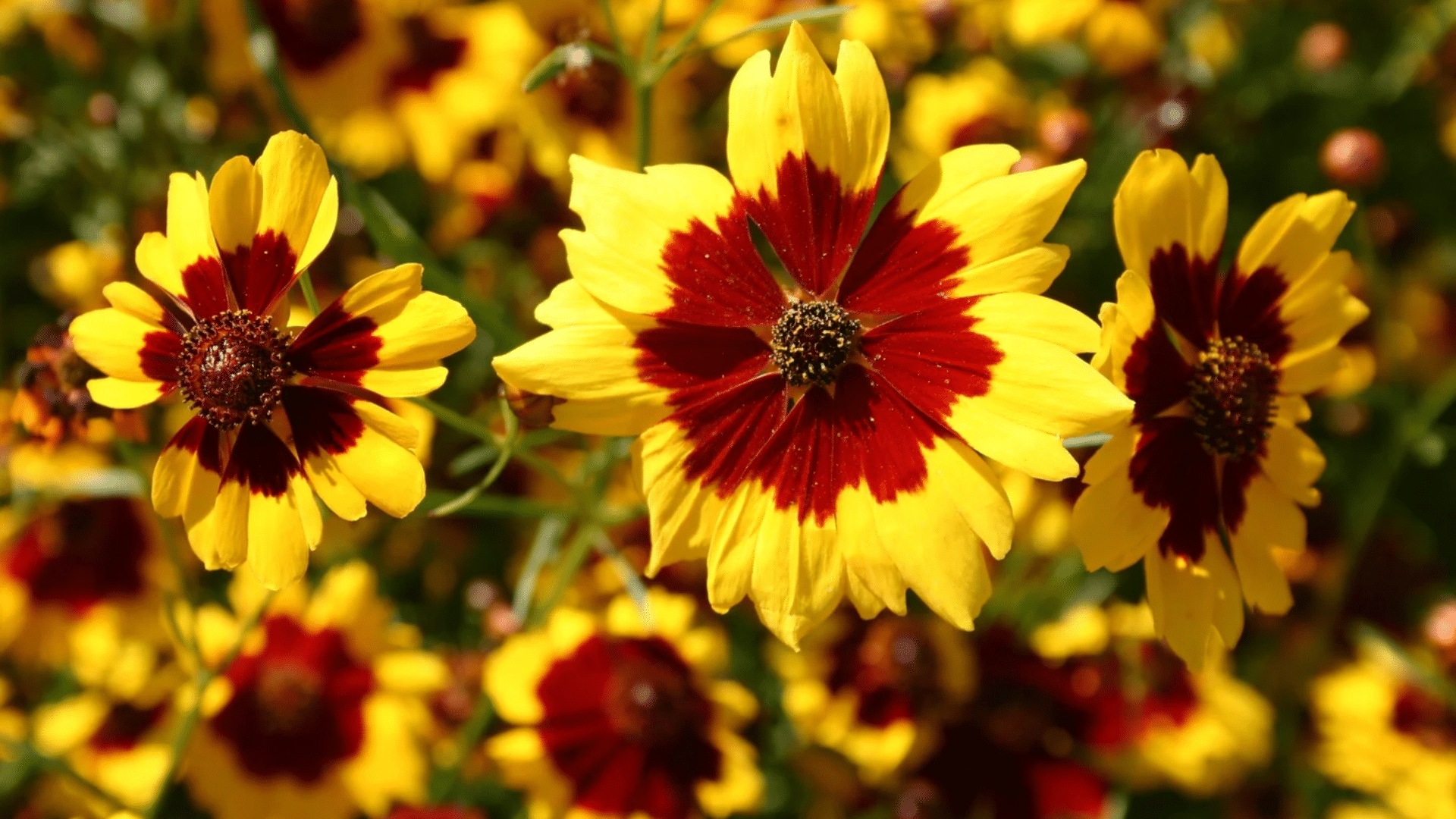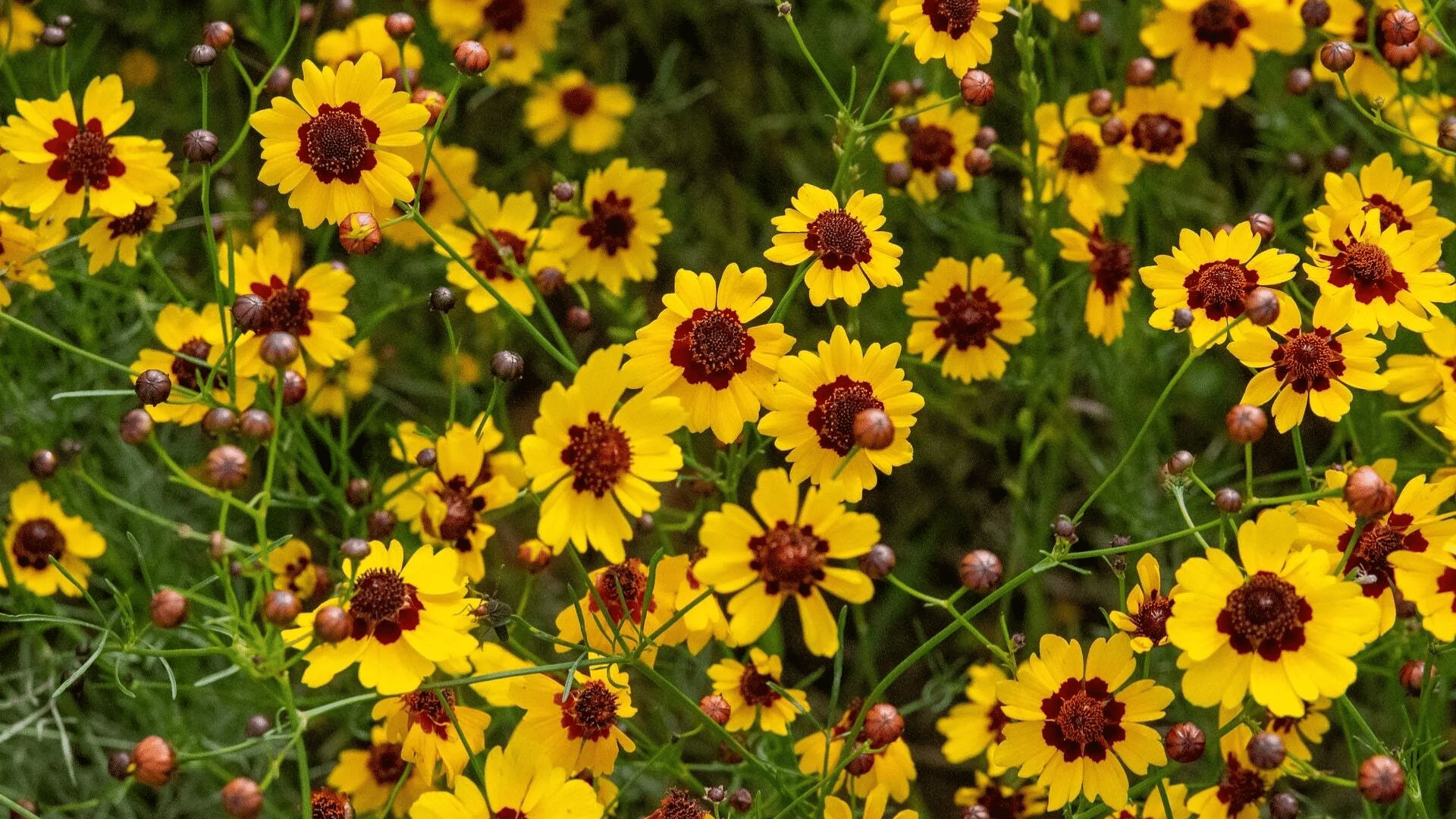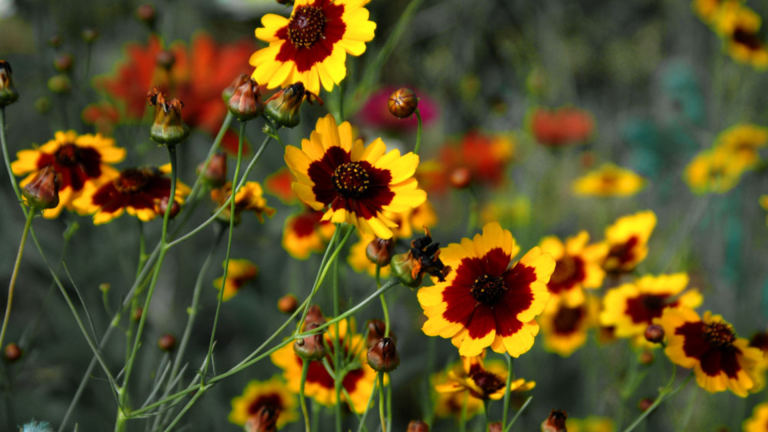If you walk through a sun-dappled prairie or pass a wildflower garden in summer, you might spot the cheerful yellow blooms of Plains Coreopsis (Coreopsis tinctoria).
If you’ve ever spotted bright, daisy-like flowers with yellow petals and maroon tips dancing in the breeze, you’ve likely met Plains Coreopsis.
I see it everywhere – from my own garden beds to open meadows in public parks – and it never fails to catch my eye.
This hardy native wildflower doesn’t just add bold color; it also attracts bees and butterflies all season long.
In this blog, I’ll share why Plains Coreopsis is a favorite for gardeners and nature lovers alike, and how you can grow it to bring vibrant life to your own space.
What is Plains Coreopsis?

Plains Coreopsis, sometimes called “Golden Tickseed,” is an annual wildflower native to the central United States, especially the Great Plains.
It blooms from late spring to early fall, adding golden color to roadsides and gardens. Growing 1–3 feet tall with ferny foliage and daisy-like flowers, it thrives in full sun and poor soil.
Drought-tolerant and low-maintenance, it reseeds easily and fills spaces quickly. Ideal for pollinator gardens, it blends well with other natives and brings lasting color with minimal care.
Plant Characteristics
- Height: Grows 1–3 feet tall
- Flowers: Single, daisy-like heads 1–2 inches wide, yellow petals often with maroon bases
- Foliage: Finely divided, ferny, and airy
- Lifetime: Annual (completes its life cycle in one season) but often self-seeds for recurring blooms
- Root System: Fibrous, helps stabilize soil and prevent erosion
- Growth Rate: Germinates and flowers quickly, making it ideal for filling gaps in garden beds and prairie restorations
Growing Conditions
- Sunlight: Requires full sun for best growth and flower production
- Soil: Thrives in a variety of soils—sandy, clay, loamy; tolerates poor and disturbed ground
- Water Needs: Highly drought-tolerant once established; prefers moderate moisture but adaptable to dry spells
- pH Range: Handles a broad range but prefers slightly acidic to neutral soils
- Spacing: Sow seeds with at least 6 inches between plants to avoid overcrowding
- Fertilizer: Minimal to none; too much fertilizer produces foliage at the expense of blooms
- Maintenance: Deadheading prolongs blooming, but letting some seeds form ensures natural reseeding
- Cold/Heat Tolerance: Withstands both cool nights and hot summer days, typical of prairie environments
Plains Coreopsis: Origin and Natural Habitat
Plains Coreopsis (Coreopsis tinctoria) is native to the Great Plains of central North America, especially prevalent from Texas through the Midwest and into southern Canada.
You find this annual wildflower thriving in open prairies, savannas, riverbanks, and disturbed areas like roadsides and abandoned fields.
It prefers full sun and moist, sandy or clay soils, but handles drought and poor soils remarkably well, making it a resilient choice for a range of natural settings.
The plant often colonizes areas after disturbance, forming dense stands that bring vibrant yellow and maroon colors to the landscape throughout its broad range.
It adapts easily, which is why you often see it thriving in both wild and restored habitats. I’ve noticed it quickly fills in bare patches, making it ideal for erosion control or low-care landscapes.
You can count on it to bloom even in places where other flowers struggle. Its ability to flourish in such varied conditions shows just how tough and reliable this native plant really is.
Seasonal Bloom and Flowering Cycle of Plains Coreopsis

You’ll see Plains Coreopsis flowering from late spring into early fall, with peak bloom usually from June through August in most regions. The plant rapidly grows from seed to flower within a single season, reaching heights of one to three feet.
Its daisy-like flowers open atop slender stems, displaying yellow petals with dark maroon bases. Prolonged flowering is common if you remove spent blooms, and allowing some to go to seed encourages natural reseeding for the next year.
The abundance and duration of its blooms provide crucial nectar and pollen for pollinators well into late summer, extending seasonal color in your landscape.
I love how it keeps your garden colorful while other plants begin to fade. You’ll notice fresh blooms appearing regularly, especially if you take a few minutes to deadhead now and then.
Even a small patch can stay vibrant for months, drawing bees and butterflies nonstop. Its long blooming season makes it one of the most rewarding flowers you can grow.
Plains Coreopsis: Benefits for Pollinators and Wildlife
Plains Coreopsis is more than a bright bloom; it’s a hardworking plant that supports a wide variety of garden wildlife. From summer through fall, you’ll see nonstop activity around it.
I often find myself watching bees and butterflies hover around the flowers, and later in the season, birds arrive for the seeds. It’s a simple way to add life to your landscape.
Here’s how it helps:
- Bees and Butterflies: Provides rich nectar and pollen all season long
- Birds: Goldfinches and others feed on seeds in late fall
- Insects: Supports native bees, hoverflies, and other pollinators
- Self-sustaining habitat: Encourages natural biodiversity with minimal effort
With just a small patch, you offer food and shelter to the pollinators your garden depends on.
Planting and Propagation Tips for Plains Coreopsis
If you scatter Coreopsis tinctoria seeds in your garden, you’ll find them germinating easily. Just press them into bare soil in early spring.
These flowers rarely need fertilizing. I like how they self-seed prolifically, often coming back year after year if I leave the seed heads on the plant at the end of the season.
You can mix Plains Coreopsis with other native wildflowers like Black-eyed Susan, Blanketflower, or Purple Coneflower. They stand tall in wild borders, open beds, or even containers, creating a habitat you and pollinators both will love.
- Sow seeds directly into prepared soil as soon as the danger of frost has passed
- Lightly press seeds into the ground—they need sun to germinate
- Prefers full sun and moderately moist, well-drained soils
- Tolerates both drought and occasional flooding
- Avoid heavy fertilization
- Once established, it often self-seeds
- Thin seedlings if overly dense for healthier, longer-flowering plants
Common Issues and How to Prevent Them
Plains Coreopsis is one of the lowest-maintenance flowers I grow. It rarely suffers from pests or disease, which makes it perfect if you want something easy and reliable. Still, a few issues can show up from time to time, but they’re simple to handle.
Here’s what to watch for:
- Powdery mildew: May appear in humid weather; improve air flow by thinning plants
- Overcrowding: Thin seedlings early to allow sunlight and reduce competition
- Weeds: Compete for space and nutrients; apply light mulch or weed by hand
- Overwatering: Avoid soggy soil; this plant prefers drier conditions once established
With a little space and sunlight, it practically takes care of itself.
Conclusion
Each summer, the sight of Plains Coreopsis reminds me there is simple joy in wild gardens and resilient blooms. When I plant these golden flowers, I know you and I help bees, butterflies, and birds thrive, all with minimal effort.
Their carefree sway in the breeze, bold color, and ability to self-seed mean they’ll be back long after the season ends.
I think you’ll find there’s always a place for this prairie wildflower, one that transforms even the roughest patch of earth into a living tapestry of gold and crimson.
If you crave beauty, ease, and pollinator power in your landscape, Plains Coreopsis is a gift that keeps on giving.
It asks for very little and gives back so much in return. I truly believe once you grow it, you’ll want it in your garden every year.
Its presence brings a sense of calm and connection to the natural world. You’ll see how something so simple can bring lasting joy to your space.













